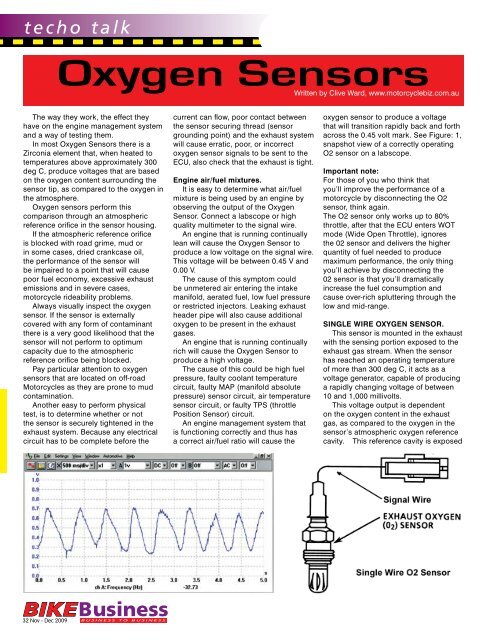Issue 014 - Bike Business Magazine Home Page
Issue 014 - Bike Business Magazine Home Page
Issue 014 - Bike Business Magazine Home Page
Create successful ePaper yourself
Turn your PDF publications into a flip-book with our unique Google optimized e-Paper software.
t e c h o t a l k<br />
Oxygen Sensors<br />
Written by Clive Ward, www.motorcyclebiz.com.au<br />
The way they work, the effect they<br />
have on the engine management system<br />
and a way of testing them.<br />
In most Oxygen Sensors there is a<br />
Zirconia element that, when heated to<br />
temperatures above approximately 300<br />
deg C, produce voltages that are based<br />
on the oxygen content surrounding the<br />
sensor tip, as compared to the oxygen in<br />
the atmosphere.<br />
Oxygen sensors perform this<br />
comparison through an atmospheric<br />
reference orifice in the sensor housing.<br />
If the atmospheric reference orifice<br />
is blocked with road grime, mud or<br />
in some cases, dried crankcase oil,<br />
the performance of the sensor will<br />
be impaired to a point that will cause<br />
poor fuel economy, excessive exhaust<br />
emissions and in severe cases,<br />
motorcycle rideability problems.<br />
Always visually inspect the oxygen<br />
sensor. If the sensor is externally<br />
covered with any form of contaminant<br />
there is a very good likelihood that the<br />
sensor will not perform to optimum<br />
capacity due to the atmospheric<br />
reference orifice being blocked.<br />
Pay particular attention to oxygen<br />
sensors that are located on off-road<br />
Motorcycles as they are prone to mud<br />
contamination.<br />
Another easy to perform physical<br />
test, is to determine whether or not<br />
the sensor is securely tightened in the<br />
exhaust system. Because any electrical<br />
circuit has to be complete before the<br />
current can flow, poor contact between<br />
the sensor securing thread (sensor<br />
grounding point) and the exhaust system<br />
will cause erratic, poor, or incorrect<br />
oxygen sensor signals to be sent to the<br />
ECU, also check that the exhaust is tight.<br />
Engine air/fuel mixtures.<br />
It is easy to determine what air/fuel<br />
mixture is being used by an engine by<br />
observing the output of the Oxygen<br />
Sensor. Connect a labscope or high<br />
quality multimeter to the signal wire.<br />
An engine that is running continually<br />
lean will cause the Oxygen Sensor to<br />
produce a low voltage on the signal wire.<br />
This voltage will be between 0.45 V and<br />
0.00 V.<br />
The cause of this symptom could<br />
be unmetered air entering the intake<br />
manifold, aerated fuel, low fuel pressure<br />
or restricted injectors. Leaking exhaust<br />
header pipe will also cause additional<br />
oxygen to be present in the exhaust<br />
gases.<br />
An engine that is running continually<br />
rich will cause the Oxygen Sensor to<br />
produce a high voltage.<br />
The cause of this could be high fuel<br />
pressure, faulty coolant temperature<br />
circuit, faulty MAP (manifold absolute<br />
pressure) sensor circuit, air temperature<br />
sensor circuit, or faulty TPS (throttle<br />
Position Sensor) circuit.<br />
An engine management system that<br />
is functioning correctly and thus has<br />
a correct air/fuel ratio will cause the<br />
oxygen sensor to produce a voltage<br />
that will transition rapidly back and forth<br />
across the 0.45 volt mark. See Figure: 1,<br />
snapshot view of a correctly operating<br />
O2 sensor on a labscope.<br />
Important note:<br />
For those of you who think that<br />
you’ll improve the performance of a<br />
motorcycle by disconnecting the O2<br />
sensor, think again.<br />
The O2 sensor only works up to 80%<br />
throttle, after that the ECU enters WOT<br />
mode (Wide Open Throttle), ignores<br />
the 02 sensor and delivers the higher<br />
quantity of fuel needed to produce<br />
maximum performance, the only thing<br />
you’ll achieve by disconnecting the<br />
02 sensor is that you’ll dramatically<br />
increase the fuel consumption and<br />
cause over-rich spluttering through the<br />
low and mid-range.<br />
SINGLE WIRE OXYGEN SENSOR.<br />
This sensor is mounted in the exhaust<br />
with the sensing portion exposed to the<br />
exhaust gas stream. When the sensor<br />
has reached an operating temperature<br />
of more than 300 deg C, it acts as a<br />
voltage generator, capable of producing<br />
a rapidly changing voltage of between<br />
10 and 1,000 millivolts.<br />
This voltage output is dependent<br />
on the oxygen content in the exhaust<br />
gas, as compared to the oxygen in the<br />
sensor’s atmospheric oxygen reference<br />
cavity. This reference cavity is exposed<br />
BIKE<strong>Business</strong><br />
32 Nov - Dec 2009 b u s i n e s s t o b u s i n e s s
















